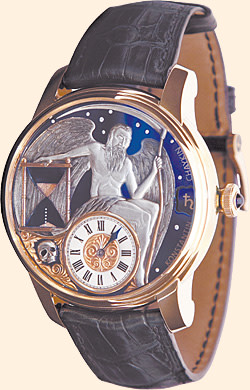Profile: Konstantin Chaykin

Roula Khalaf, Editor of the FT, selects her favourite stories in this weekly newsletter.
Collectors do not necessarily regard Russian watches as a first-class product, and Moscow is not usually considered a centre of excellence in the haute horlogerie world.
Konstantin Chaykin, a Russian-born watchmaker, intends to change that.
He points out that before the Russian Revolution of 1917 and the subsequent Soviet era, high-quality, complicated timepieces were produced in the capital.
“Communist ideologists tried to wipe from people’s memories everything that was good before the revolution of 1917,” he says. “Sadly, this also affected clock- and watchmaking.”
As evidence of his city’s forgotten tradition, he points to timepieces built by Terentiy Ivanovich Voloskov, by the Bronnikov family and by Ivan Kulibin, who presented a clock to Empress Catherine II of Russia.
At his workshop, Mr Chaykin produces about 250 pieces every year, costing between $16,000 and $165,000.

He aims to appeal to buyers in Europe, Asia and the Middle East, as well as in his native country.
He is serious about the “Russian made” description, producing most of the parts in his workshop with the rest sourced within the country.
He even buys the hairspring, a tricky part to manufacture, from Raketa, a supplier based in St Petersburg.
Though Mr Chaykin can construct high complications such as the Tourbillon 55, he prefers to invent novel complications that play with representations of time.
“Timepieces with a Russian soul contain a different worldview, a different perception of time,” he explains. “Hence they are different – different from, let’s say, Swiss timepieces.”
The Decalogue Rega counts the ancient Jewish units of time halakim and regaim as well as the modern 24 hours. The helek, which means “part” in Aramaic, equals 3 1/3 seconds, while the rega, “the twinkling of an eye” in Hebrew, is 44 milliseconds, which makes it the smallest measured unit of time in a watch.
The Quartime divides a day into morning, day, evening and night, integrated into a traditional dial. It features a revolving indicator that completes a quarter of a circle every six hours; apertures show the passing hours and segments of the day.

Last year, Mr Chaykin launched the Cinema, a camera-shaped watch that includes a 20-second animated film on the dial activated by a crown on the bezel.
The Cinema offers not only an image but also the sound of an old movie projector as the horse and rider “gallop” in the frame.
Mr Chaykin’s accomplishments have been recognised by his peers. He is the only Russian watchmaker to become a member of the prestigious Académie Horlogère des Créateurs Indépendants.
“He is able to make very aesthetic and unique watches,” says Svend Andersen, one of the founders of the AHCI.
Mr Chaykin’s most recent creation is the Carpe Diem, which represents the abstract concept of time using metaphors from western mythology.
Chronos, the Greek god of time, sits on an off-centre dial that shows the hours against a starry night sky. One of his hands holds a scythe, while the other leans on an hourglass that tracks the minutes through the appearance of flowing sand.
Mr Chaykin created the illusion using a shutter system, for which he received a patent.
Carpe Diem also includes a skull and date indicator, which employs astrological signs instead of numbers.

Since opening his workshop, Mr Chaykin has created 26 calibres and been granted 17 patents.
“Konstantin’s work in recent years has really amazed me,” says Max Büsser, the founder and owner of MB & F, an independent Swiss watch manufacturer.
“On a design perspective, we are not on the same planet, but he manages to instil a real sense of whimsy and childhood awe in his creations.
“Something makes his watchmaking art so personal and unique in a world where real creativity has become all too rare.”
Mr Chaykin hopes to maintain the momentum he has sparked in Russian horology.
There are no professional watchmaking schools in Russia, so he has decided to tackle the problem by training young enthusiasts through an apprentice system at his atelier in Moscow.
“We are creating traditions,” says Mr Chaykin. “Step by step, cog by cog, here in Russia we are creating our own watchmaking school and raising our own generation of world-class watchmakers.”
Comments